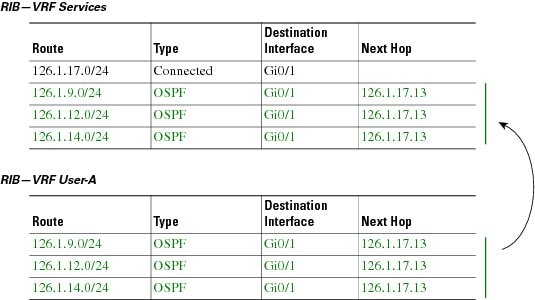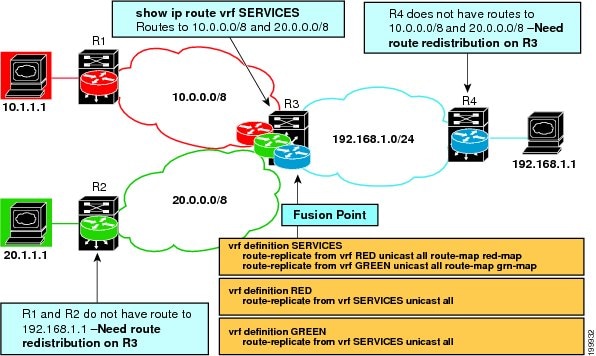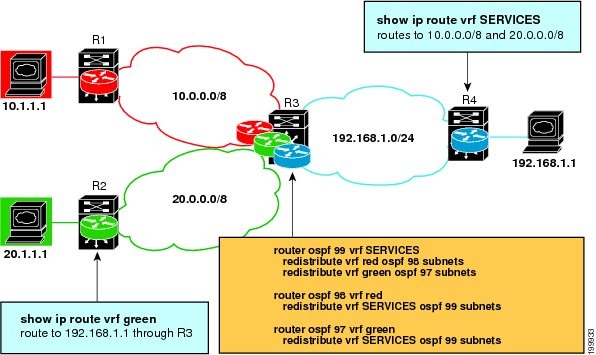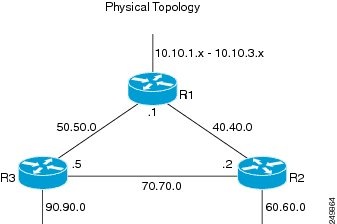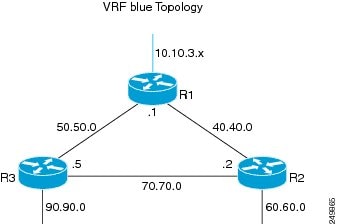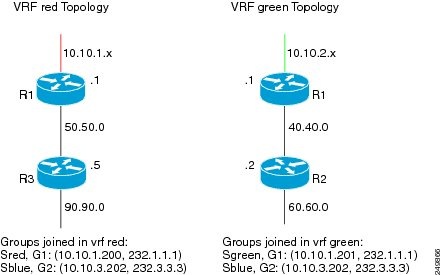 Feedback Feedback
|
Contents
- Configuring Easy Virtual Network Shared Services
- Finding Feature Information
- Prerequisites for Virtual IP Network Shared Services
- Restrictions for Virtual IP Network Shared Services
- Information About Easy Virtual Network Shared Services
- Shared Services in an Easy Virtual Network
- Easy Virtual Network Makes Shared Services Easier Than VRF-Lite Does
- Route Replication Process in EVN
- Where to Implement Route Replication
- Route Replication Behavior for EVN
- Route Preference Rules After Route Replication in EVN
- How to Share Services Using Easy Virtual Network
- Configuring Route Replication to Share Services in EVN
- Example
- What to Do Next
- Configuring Redistribution to Share Services in EVN
- Configuration Example for EVN Shared Services
- Example: EVN Route Replication and Route Redistribution in a Multicast Environment
- Additional References
- Feature Information for Easy Virtual Network Shared Services
Configuring Easy Virtual Network Shared Services
This module describes how to use route replication and redistribution to share services in an Easy Virtual Network (EVN).
- Finding Feature Information
- Prerequisites for Virtual IP Network Shared Services
- Restrictions for Virtual IP Network Shared Services
- Information About Easy Virtual Network Shared Services
- How to Share Services Using Easy Virtual Network
- Configuration Example for EVN Shared Services
- Additional References
- Feature Information for Easy Virtual Network Shared Services
Finding Feature Information
Your software release may not support all the features documented in this module. For the latest feature information and caveats, see the release notes for your platform and software release. To find information about the features documented in this module, and to see a list of the releases in which each feature is supported, see the Feature Information Table at the end of this document.
Use Cisco Feature Navigator to find information about platform support and Cisco software image support. To access Cisco Feature Navigator, go to www.cisco.com/go/cfn. An account on Cisco.com is not required.
Prerequisites for Virtual IP Network Shared Services
- Read the Overview of Easy Virtual Networks section .
- Implement Easy Virtual Network based on the Configuring Easy Virtual Networks section.
Restrictions for Virtual IP Network Shared Services
Route replication is supported for static, EIGRP, and OSPF routes. It is not possible to replicate routes to and from BGP, but that is not an issue because the BGP import and export method of copying routes between VRFs is available in a virtual network.
Information About Easy Virtual Network Shared Services
- Shared Services in an Easy Virtual Network
- Easy Virtual Network Makes Shared Services Easier Than VRF-Lite Does
- Route Replication Process in EVN
- Route Replication Behavior for EVN
- Route Preference Rules After Route Replication in EVN
Shared Services in an Easy Virtual Network
There are some common services (such as database servers and application servers) that multiple virtual networks need to access. Shared services are beneficial because:
- Services are usually not duplicated for each group.
- Sharing services is economical.
- Sharing services is efficient and manageable.
- Policies can be centrally deployed.
To achieve route separation, you could replicate the service, either physically or virtually, one service for each virtual network. However, that solution might not be cost effective or feasible. For a router that supports EVN, the solution is to perform route replication and route redistribution.
Route replication allows shared services because when routes are replicated between virtual networks, clients who reside in one virtual network can reach prefixes that exist in another virtual network.
A shared services approach works best for DNS, DHCP, and corporate communications. It is not a solution for sharing access to an internet gateway.
Easy Virtual Network Makes Shared Services Easier Than VRF-Lite Does
Sharing servers in VRF-Lite requires route distinguishers (RDs), route targets with importing and exporting, and configuring BGP.
In an EVN environment, shared services are achieved with route replication, which is a simple deployment. Route replication requires no BGP, no RD, no route targets, and no import or export.
In summary, the BGP import and export method of copying routes between VRFs works with both VRF-Lite and EVN. However, route replication is the simpler alternative to enable sharing of common services across multiple virtual networks.
Route Replication Process in EVN
With shared service, clients and servers are located in different virtual networks. To achieve connectivity between clients and servers, routes must be exchanged among virtual networks. Such route exchanges among VRFs are accomplished in two different ways, depending on whether VRF-Lite or EVN is implemented:
- In VRF-Lite, route leaking is achieved, via BGP, by using the route import/export feature.
- In EVN, route replication is supported directly by the RIB; there is no dependency on BGP. After routes are replicated from a different virtual network, those routes are propagated across each virtual network through existing redistribution into the Interior Gateway Protocol (IGP).
In the following route replication scenario, a router has two VRFs named Services and User-A. OSPF is configured:
router ospf 99 vrf services network 126.1.0.0 0.0.255.255 area 0 ! router ospf 98 vrf user-a network 126.1.0.0 0.0.255.255 area 0
Furthermore, route replication is configured for VRF User-A:
vrf definition user-a ! address-family ipv4 route-replicate from vrf services unicast ospf 99 exit-address-family
In the scenario, the following RIB for the VRF Services contains four routes, three of which are replicated to the RIB for VRF User-A. Route replication creates a link to the source RIB, as shown in the figure below.
Configuring route replication allows mutual redistribution between virtual IP networks. In the case of shared services, you would configure route replication within the VRF that needs access to the shared services. Within each route-replicate command, you can optionally filter out routes with a route map to prevent a routing loop. That is, you do not want to redistribute routes back into the original routing protocol. You do not want a native route to show up as a replicated route.
Where to Implement Route Replication
We recommend implementing route replication on the router as close to the shared service as possible. Ideally, the router that is directly connected to the server subnet should be used, to eliminate the need to redistribute the host prefixes on the server VRF, and thereby avoid a potential routing loop.
Route Replication Behavior for EVN
This section describes the behavior of route replication for EVN, which differs from the behavior for Multi-Topology Routing. In the EVN environment:
- The route-replicate command is accepted only under the address-family ipv4 command, which is configured under the vrf definition command.
- The route-replicate command replicates routes into the base topology within the specified address family.
- If all is specified as a source protocol, only one route-replicate command is allowed per VRF for a given destination topology.
- The no route-replicate command is allowed to exclude a source protocol.
- If all is specified as a source protocol, then connected routes are replicated (unlike in the Multi-Topology Routing version of the route-replicate command).
- A replicated route inherits the administrative distance and source protocol of the source route.
Route Preference Rules After Route Replication in EVN
If a route is replicated, the following rules determine route preference:
- If two routes are owned by the same protocol (for example, both are EIGRP routes), and both routes have the same source VRF and one of the routes is NOT replicated, then the non-replicated route is preferred.
If the above rule does not apply, the following rules determine route preference, in this order:
- Prefer the route with smaller administrative distance.
- Prefer the route with smaller default administrative distance.
- Prefer a non-replicated route over a replicated route.
- Compare original vrf-names. Prefer the route with the lexicographically smaller vrf-name.
- Compare original sub-address-families: Prefer unicast over multicast.
- Prefer the oldest route.
How to Share Services Using Easy Virtual Network
- Configuring Route Replication to Share Services in EVN
- Configuring Redistribution to Share Services in EVN
Configuring Route Replication to Share Services in EVN
Perform this task to replicate routes from one VRF to another. The examples within this task table are based on the figure below.
In this particular task, routes from VRF SERVICES are replicated to both VRF RED and VRF GREEN, and VRF RED and VRF GREEN are not allowed to share routes between them. In order to allow bidirectional traffic, routes from VRF RED and VRF GREEN are also replicated to VRF SERVICES.
DETAILED STEPS
Example
The following is the output from the show ip route vrfcommand based on the task in the preceding task table:
Router# show ip route vrf RED
Routing Table: RED
Codes: L - local, C - connected, S - static, R - RIP, M - mobile, B - BGP
D - EIGRP, EX - EIGRP external, O - OSPF, IA - OSPF inter area
N1 - OSPF NSSA external type 1, N2 - OSPF NSSA external type 2
E1 - OSPF external type 1, E2 - OSPF external type 2
i - IS-IS, su - IS-IS summary, L1 - IS-IS level-1, L2 - IS-IS level-2
ia - IS-IS inter area, * - candidate default, U - per-user static route
o - ODR, P - periodic downloaded static route, H - NHRP, l - LISP
+ - replicated route, % - next hop override
Gateway of last resort is not set
192.168.1.0/24 is variably subnetted, 2 subnets, 2 masks
C + 192.168.1.0/24 is directly connected (SERVICES), GigabitEthernet0/0/0
L + 192.168.1.3/32 is directly connected (SERVICES), GigabitEthernet0/0/0
Router#
What to Do Next
After you perform the task Configuring Route Replication to Share Services in EVN (and the parallel task for VRF GREEN in the Figure above, Router 3 has routes to 10.0.0.0/8 and 20.0.0.0/8. Also, Router 1 and Router 2 have a route to 192.168.1.0/24.
However, Router 1 and Router 2 still do not have a route to the shared service residing on 192.168.1.1. And Router 4 does not have routes to 10.0.0.0/8 and 20.0.0.0/8. Such access requires the route redistribution performed in the next task, Configuring Redistribution to Share Services in EVN.
Configuring Redistribution to Share Services in EVN
This task is based on the assumption that you also performed the task, Configuring Route Replication to Share Services in EVN.
The figure below shows the same networks we used in the figure above. In this task, we perform redistribution on Router 3 so that Router 1 and Router 2 have a route to the shared service residing on 192.168.1.1.
DETAILED STEPS
Configuration Example for EVN Shared Services
Example: EVN Route Replication and Route Redistribution in a Multicast Environment
In the figures above there are three multicast streams:
- Sred, G1: (10.10.1.200, 232.1.1.1)--Source and receivers in VRF red
- Sgreen, G1: (10.10.2.201, 232.1.1.1)--Source and receivers in VRF green
- Sblue, G2: (10.10.3.202, 232.3.3.3)--Source in blue and receivers in VRFs red and green.
The server-prefix in VRF blue (10.10.3.0/24) is replicated and distributed into VRFs red and green on R3 and R2.
Multicast group 232.3.3.3 with its source in VRF blue has receivers in both VRF red and VRF green. The stream is transmitted over the shared VRF (blue), and then replicated into VRF red on R3 and into VRF green on R2.
R1 Configuration
vrf definition blue vnet tag 4 ! address-family ipv4 exit-address-family ! vrf definition green vnet tag 3 ! address-family ipv4 exit-address-family ! vrf definition red vnet tag 2 ! address-family ipv4 exit-address-family ! vrf list vnet-list1 member blue member red ! vrf list vnet-list2 member blue member green ! vrf list vnet-list3 member blue ! ip multicast-routing distributed ip multicast-routing vrf red distributed ip multicast-routing vrf green distributed ip multicast-routing vrf blue distributed ! interface FastEthernet0/0/2 vnet trunk list vnet-list1 [vnet trunk for red and blue] ip address 50.50.0.1 255.255.255.0 no ip redirects no ip proxy-arp ip pim sparse-dense-mode ! interface GigabitEthernet0/1/1 vnet trunk list vnet-list2 [vnet trunk for green and blue] ip address 40.40.0.1 255.255.255.0 no ip redirects no ip proxy-arp ip pim sparse-dense-mode ! interface GigabitEthernet0/1/3 ip address 10.10.0.1 255.255.255.0 no ip redirects no ip proxy-arp ip pim sparse-dense-mode ! interface GigabitEthernet0/1/3.2 vrf forwarding red encapsulation dot1Q 2 ip address 10.10.1.1 255.255.255.0 ip pim sparse-dense-mode ! interface GigabitEthernet0/1/3.3 vrf forwarding green encapsulation dot1Q 3 ip address 10.10.2.1 255.255.255.0 ip pim sparse-dense-mode ! interface GigabitEthernet0/1/3.4 vrf forwarding blue encapsulation dot1Q 4 ip address 10.10.3.1 255.255.255.0 ip pim sparse-dense-mode ! router ospf 201 vrf red nsf redistribute connected subnets network 10.10.1.0 0.0.0.255 area 0 network 50.50.0.0 0.0.0.255 area 0 ! router ospf 202 vrf green nsf network 10.10.2.0 0.0.0.255 area 0 network 40.40.0.0 0.0.0.255 area 0 ! router ospf 203 vrf blue router-id 11.11.11.11 nsf network 10.10.3.0 0.0.0.255 area 0 network 40.40.0.0 0.0.0.255 area 0 network 50.50.0.0 0.0.0.255 area 0 ! router ospf 200 nsf redistribute connected subnets network 10.10.0.0 0.0.0.255 area 0 network 40.40.0.0 0.0.0.255 area 0 network 50.50.0.0 0.0.0.255 area 0 ! ip pim ssm default ip pim vrf red ssm default ip pim vrf green ssm default ip pim vrf blue ssm default !
R2 Configuration
vrf definition blue vnet tag 4 ! address-family ipv4 exit-address-family ! vrf definition green vnet tag 3 ! address-family ipv4 route-replicate from vrf blue unicast all route-map blue-map [replicate routes from blue to green] exit-address-family ! vrf definition red vnet tag 2 ! address-family ipv4 exit-address-family ! vrf list vnet-list1 member blue member green ! vrf list vnet-list2 member blue ! ip multicast-routing distributed ip multicast-routing vrf red distributed ip multicast-routing vrf green distributed ip multicast-routing vrf blue distributed ! interface FastEthernet0/0/6 vnet trunk list vnet-list2 [vnet trunk for blue] ip address 70.70.0.2 255.255.255.0 no ip redirects no ip proxy-arp ip pim sparse-dense-mode ! interface GigabitEthernet0/1/2 vnet trunk list vnet-list1 [vnet trunk for green and blue] ip address 40.40.0.2 255.255.255.0 no ip redirects no ip proxy-arp ip pim sparse-dense-mode ! interface GigabitEthernet0/1/4 vnet trunk list vnet-list1 [vnet trunk for green and blue] ip address 60.60.0.2 255.255.255.0 no ip redirects no ip proxy-arp ip pim sparse-dense-mode ! router ospf 202 vrf green redistribute connected subnets redistribute vrf blue ospf 203 subnets route-map blue-map [redistribute routes replicated from blue in red] network 40.40.0.0 0.0.0.255 area 0 network 60.60.0.0 0.0.0.255 area 0 ! router ospf 203 vrf blue router-id 22.22.22.22 network 40.40.0.0 0.0.0.255 area 0 network 60.60.0.0 0.0.0.255 area 0 network 70.70.0.0 0.0.0.255 area 0 ! router ospf 200 redistribute connected subnets network 40.40.0.0 0.0.0.255 area 0 network 60.60.0.0 0.0.0.255 area 0 network 70.70.0.0 0.0.0.255 area 0 ! ip pim ssm default ip pim vrf red ssm default ip pim vrf green ssm default ip pim vrf blue ssm default ! ip prefix-list server-prefix seq 5 permit 10.10.3.0/24 ! route-map blue-map permit 10 match ip address prefix-list server-prefix !
R3 Configuration
vrf definition blue vnet tag 4 ! address-family ipv4 exit-address-family ! vrf definition green vnet tag 3 ! address-family ipv4 exit-address-family ! vrf definition red vnet tag 2 ! address-family ipv4 route-replicate from vrf blue unicast all route-map blue-map [replicate routes from blue to red] exit-address-family ! vrf list vnet-list1 member blue member red ! vrf list vnet-list2 member blue ! ip multicast-routing distributed ip multicast-routing vrf red distributed ip multicast-routing vrf green distributed ip multicast-routing vrf blue distributed ! interface GigabitEthernet0/2/0 vnet trunk list vnet-list1 [vnet trunk for red and blue] ip address 90.90.0.5 255.255.255.0 no ip redirects no ip proxy-arp ip pim sparse-dense-mode ! interface GigabitEthernet1/2/0 vnet trunk list vnet-list1 [vnet trunk for red and blue] ip address 50.50.0.5 255.255.255.0 no ip redirects no ip proxy-arp ip pim sparse-dense-mode ! interface FastEthernet2/0/0 vnet trunk list vnet-list2 [vnet trunk for blue] ip address 70.70.0.5 255.255.255.0 no ip redirects no ip proxy-arp ip pim sparse-dense-mode ! router ospf 201 vrf red redistribute connected subnets redistribute vrf blue ospf 203 subnets route-map blue-map [redistribute routes replicated from blue in red] network 50.50.0.0 0.0.0.255 area 0 network 90.90.0.0 0.0.0.255 area 0 ! router ospf 203 vrf blue router-id 55.55.55.55 network 50.50.0.0 0.0.0.255 area 0 network 70.70.0.0 0.0.0.255 area 0 network 90.90.0.0 0.0.0.255 area 0 ! router ospf 200 redistribute connected subnets network 50.50.0.0 0.0.0.255 area 0 network 70.70.0.0 0.0.0.255 area 0 network 90.90.0.0 0.0.0.255 area 0 ! ip pim ssm default ip pim vrf red ssm default ip pim vrf green ssm default ip pim vrf blue ssm default ! ip prefix-list server-prefix seq 5 permit 10.10.3.0/24 ! route-map blue-map permit 10 match ip address prefix-list server-prefix !
Additional References
Related Documents
|
Related Topic |
Document Title |
|---|---|
|
Cisco IOS commands |
|
|
Easy Virtual Network commands |
|
|
Overview of Easy Virtual Network |
"Overview of Easy Virtual Network" module in the Easy Virtual Network Configuration Guide. |
|
Configuring Easy Virtual Network |
"Configuring Easy Virtual Network" module in the Easy Virtual Network Configuration Guide. |
|
Easy Virtual Network management and troubleshooting |
"Easy Virtual Network Management and Troubleshooting" module in the Easy Virtual Network Configuration Guide. |
MIBs
Technical Assistance
|
Description |
Link |
|---|---|
|
The Cisco Support and Documentation website provides online resources to download documentation, software, and tools. Use these resources to install and configure the software and to troubleshoot and resolve technical issues with Cisco products and technologies. Access to most tools on the Cisco Support and Documentation website requires a Cisco.com user ID and password. |
Feature Information for Easy Virtual Network Shared Services
The following table provides release information about the feature or features described in this module. This table lists only the software release that introduced support for a given feature in a given software release train. Unless noted otherwise, subsequent releases of that software release train also support that feature.
Use Cisco Feature Navigator to find information about platform support and Cisco software image support. To access Cisco Feature Navigator, go to www.cisco.com/go/cfn. An account on Cisco.com is not required.
| Table 1 | Feature Information for Easy Virtual Network Shared Services |
Cisco and the Cisco logo are trademarks or registered trademarks of Cisco and/or its affiliates in the U.S. and other countries. To view a list of Cisco trademarks, go to this URL: www.cisco.com/go/trademarks. Third-party trademarks mentioned are the property of their respective owners. The use of the word partner does not imply a partnership relationship between Cisco and any other company. (1110R)
Any Internet Protocol (IP) addresses and phone numbers used in this document are not intended to be actual addresses and phone numbers. Any examples, command display output, network topology diagrams, and other figures included in the document are shown for illustrative purposes only. Any use of actual IP addresses or phone numbers in illustrative content is unintentional and coincidental.
